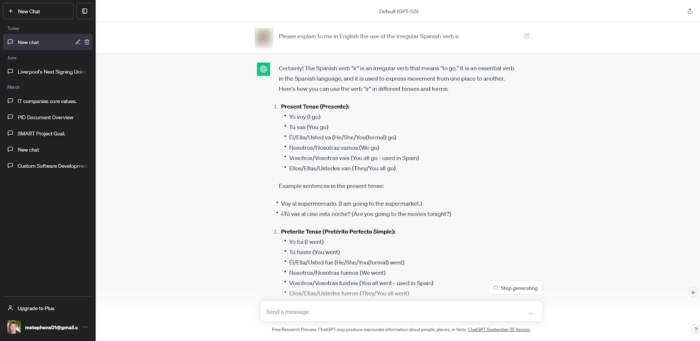5 Simple Ways AI Can Help You Learn a Language (With Tools)
Read other articles:
Back to posts
Table of Contents
- 1 1. AI-based chat for conversation practice and correcting mistakes
- 2 2. Generate quizzes and games to engage your brain
- 3 3. Boost grammar and vocabulary learning in context
- 4 4.Immerse yourself in video language learning
- 5 5.Improve speaking fluency by recording conversations
- 6 AI should supplement (not replace) language teachers

Do you think you’d be more fluent in your second language if you had a native-speaking teacher with you at all times to guide you?
For most language students, this would be the “Holy Grail” — but who can afford the daily rates of a professional language teacher?
Artificial intelligence (AI) puts a permanent, native-speaking teacher within reach in your pocket at all times. The best AI tools can correct mistakes, teach new phrases, improve fluency and do many more of the things that learners need on their journeys toward language proficiency.
That’s why, increasingly, language learners are turning to AI as a convenient and effective way to boost learning.
We’ve written an in-depth article on how to use Chat GPT to learn a language but here’s a quick overview of the ways that AI can help — and some other tools besides Chat GPT that are using AI technology to help.
1. AI-based chat for conversation practice and correcting mistakes

AI chatbots can help you practice conversations in your target language in a relaxed environment and at your own speed, without the pressure of classroom learning. Some people even interact with “AI pen pals” to help them learn a language.
With AI chatbots, the quality of the conversation will depend on the quality of your input and the way you prompt answers — but you can strike up a conversation on almost any topic.
Language learners are more likely to engage their brains when discussing a topic of interest. With AI-based learning, you’re in charge and can speak about topics of interest to you. That could be anything — attending a job interview, Premier League football, places to visit in Guatemala…whatever you like!
Language students can ask the bot to correct mistakes, explain grammar rules and suggest appropriate vocabulary. Simply prompt the bot with something like “Let’s have a conversation and please correct my mistakes”.AI research suggests that chatbots have “a positive impact on the development of learners’ English language skills” and can be helpful for vocabulary development, grammar and other foreign language skills, especially when corrective feedback is provided.
Most chatbots understand the different learning levels from C2 to A1 (that’s A-one) so you can tailor conversations to the appropriate level.
AI chatbots can’t replace conversations with teachers or other flesh-and-blood native speakers but it’s the next-best thing.
TOOLS: Chat GPT, Replika, ZenoChat, Bard, Mondly and the new breed of language-acquisition chatbots specifically designed for language learners, like LangAI
2. Generate quizzes and games to engage your brain

Gamifying language learning is a well-established way to improve engagement and stimulate interest among learners.
AI tools can help you generate quizzes and tests to benchmark your progress with the language. Just make sure that you state your proficiency level and specifically state what you want the quiz to achieve (the learning outcomes) before you generate the quiz.
A sample prompt might be: “I am studying Italian at intermediate level (B1). Create a short quiz followed by a multiple-choice reading comprehension test for me to improve my knowledge of the verb andare.”
Many of the existing, cloud-based language-learning apps use quizzes and gamification for learning vocabulary and grammar, reinforcing what has been learned and making it “fun”. Some of these apps have started to incorporate AI into their language-learning platforms.
Try to extend your learning beyond pure vocab and verb usage to sentence structure and the contextual use of words and phrases.
TOOLS: Chat GPT, Duolingo, Babbel, Memrise, Ling
3. Boost grammar and vocabulary learning in context

AI responses are generally excellent when based on rules and facts — less so when opinions, beliefs, preferences or emotional responses are required.
The following type of response from an AI chatbot sums it up well when asked for an opinion on a topic:
“As an AI, I don’t have personal opinions, emotions, or biases like humans do. My purpose is to provide information, answer questions, and generate content based on the data and algorithms I’ve been trained on.”
Fortunately for learners, languages are constructed around strict sets of rules that are generally easy for machines to learn and apply. So, for learning grammar and vocabulary, AI can effectively replace dictionaries and, to some extent, grammar-based textbooks.
Accuracy with the exact meanings of words or the endings of verbs, for instance, is generally excellent while if you ask AI to explain a particular nuance of the language, the answer may be less reliable. You may be better off seeking an answer from a textbook or online tutor.
Learning grammar and vocabulary is a necessary part of most learners’ language acquisition process — but some methods (and language learning apps) treat it as the only way.
Despite the advanced technology employed, these apps (and many YouTube video-based language tutors) still use the traditional grammar-translation method of language learning, which is inefficient compared to other language acquisition methods.
But, used in the right way, AI tools can be excellent assistants for learning grammar rules, targeted vocabulary and so on. The prompt should be something like this:
“Please explain to me in English the use of the irregular Spanish verb ir.”
One of the beauties of AI is that you can learn how grammatical forms work in specific contexts:
“Please give an example of the Spanish phrase “no estoy para las bromas” in different everyday situations”.
So, not only does AI help with the meanings of words but it can also identify phrases where these words are used.
TOOLS: Chat GPT, Replika, Duolingo, Busuu, Memrise
4.Immerse yourself in video language learning

One method of language acquisition that has been slowly increasing in popularity over the past two decades is online video learning.
There is a growing amount of high-quality video, with engaging content on almost any topic imaginable — plus the free availability of TV shows, movies and documentaries online. This, combined with the increasing sophistication of artificial intelligence, makes the likes of YouTube videos and Netflix very fertile language learning “classrooms”.
Subtitled videos in the target language can be motivational, engaging and fun for language learners, who can learn from native speakers on topics of interest while acquiring language naturally through a type of “online immersion”.
There are several tools to help with the language acquisition process, including our unique AI-powered natural language learning tool called LangApp. This helps you learn in context while building a comprehensive library of new words and phrases.
TOOLS: LangMagic (free to download and use)
5.Improve speaking fluency by recording conversations
One of the frustrations common for many language learners, particularly those who aspire to reach an advanced level with their second language, is improving fluency. This is very difficult without practicing regularly with native speakers and being corrected.
Hadar Shemesh is a very successful English tutor on YouTube, with almost 700 videos and one million subscribers. She suggests using the dialogues and texts that you generate through ChatGPT or another AI chatbot (see the first point above) and video-recording yourself speaking.
This allows you to speak about any topic of interest in a relaxed setting in your own time rather than under pressure and practicing with a topic that bores you to tears!
Listening to yourself can be a little uncomfortable but can help you identify where you can improve fluency, especially if you work in combination with an online tutor to correct you.
TOOLS: ChatGPT, Mondly, etc.
AI should supplement (not replace) language teachers
AI chatbots are not just for language learners. They’re for teachers too. Foreign language tutors can use various AI tools to motivate students, help them learn quicker, develop greater knowledge and fluency of the language and practice more at home.
This is all positive for the learning and teaching experience. Teachers can even use AI to help develop teaching materials — such as conversations around a particular topic or phrase — or even entire lesson plans.
The language teacher remains an important mentor and facilitator of language learning but many of the AI tools outlined above can be used by learners to boost the learning experience and do much of the “heavy lifting”.
For beginners, especially, the teacher remains key. For students who’ve become more advanced and want to improve fluency or even aspire to native-speaker level, AI is driving many of the tools that assist with achieving these goals, facilitating learning from interactions with native speakers.
Read other articles:
Back to posts
